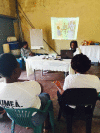Initiating a participatory action research process in the Agincourt health and socio-demographic surveillance site
- PMID: 28685035
- PMCID: PMC5475314
- DOI: 10.7189/jogh.07.010413
Initiating a participatory action research process in the Agincourt health and socio-demographic surveillance site
Abstract
Background: Despite progressive health policy, disease burdens in South Africa remain patterned by deeply entrenched social inequalities. Accounting for the relationships between context, health and risk can provide important information for equitable service delivery. The aims of the research were to initiate a participatory research process with communities in a low income setting and produce evidence of practical relevance.
Methods: We initiated a participatory action research (PAR) process in the Agincourt health and socio-demographic surveillance site (HDSS) in rural north-east South Africa. Three village-based discussion groups were convened and consulted about conditions to examine, one of which was under-5 mortality. A series of discussions followed in which routine HDSS data were presented and participants' subjective perspectives were elicited and systematized into collective forms of knowledge using ranking, diagramming and participatory photography. The process concluded with a priority setting exercise. Visual and narrative data were thematically analyzed to complement the participants' analysis.
Results: A range of social and structural root causes of under-5 mortality were identified: poverty, unemployment, inadequate housing, unsafe environments and shortages of clean water. Despite these constraints, single mothers were often viewed as negligent. A series of mid-level contributory factors in clinics were also identified: overcrowding, poor staffing, delays in treatment and shortages of medications. In a similar sense, pronounced blame and negativity were directed toward clinic nurses in spite of the systems constraints identified. Actions to address these issues were prioritized as: expanding clinics, improving accountability and responsiveness of health workers, improving employment, providing clean water, and expanding community engagement for health promotion.
Conclusions: We initiated a PAR process to gain local knowledge and prioritize actions. The process was acceptable to those involved, and there was willingness and commitment to continue. The study provided a basis from which to gain support to develop fuller forms of participatory research in this setting. The next steps are to build deeper involvement of participants in the process, expand to include the perspectives of those most marginalized, and engage in the health system at different levels to move toward an ongoing process of action and learning from action.
Conflict of interest statement
Competing interests: All authors have completed the Unified Competing Interest form at www.icmje.org/coi_disclosure.pdf (available upon request from the corresponding author), and declare no competing interests.
Figures










Similar articles
-
Community perspectives on HIV, violence and health surveillance in rural South Africa: a participatory pilot study.J Glob Health. 2016 Jun;6(1):010406. doi: 10.7189/jogh.06.010406. J Glob Health. 2016. PMID: 27231542 Free PMC article.
-
Introducing visual participatory methods to develop local knowledge on HIV in rural South Africa.BMJ Glob Health. 2017 Sep 28;2(3):e000231. doi: 10.1136/bmjgh-2016-000231. eCollection 2017. BMJ Glob Health. 2017. PMID: 29071128 Free PMC article.
-
Building cooperative learning to address alcohol and other drug abuse in Mpumalanga, South Africa: a participatory action research process.Glob Health Action. 2020;13(1):1726722. doi: 10.1080/16549716.2020.1726722. Glob Health Action. 2020. PMID: 32116156 Free PMC article.
-
The 2023 Latin America report of the Lancet Countdown on health and climate change: the imperative for health-centred climate-resilient development.Lancet Reg Health Am. 2024 Apr 23;33:100746. doi: 10.1016/j.lana.2024.100746. eCollection 2024 May. Lancet Reg Health Am. 2024. PMID: 38800647 Free PMC article. Review.
-
Folic acid supplementation and malaria susceptibility and severity among people taking antifolate antimalarial drugs in endemic areas.Cochrane Database Syst Rev. 2022 Feb 1;2(2022):CD014217. doi: 10.1002/14651858.CD014217. Cochrane Database Syst Rev. 2022. PMID: 36321557 Free PMC article.
Cited by
-
Community engagement in research in sub-Saharan Africa: current practices, barriers, facilitators, ethical considerations and the role of gender - a systematic review.Pan Afr Med J. 2022 Nov 23;43:152. doi: 10.11604/pamj.2022.43.152.36861. eCollection 2022. Pan Afr Med J. 2022. PMID: 36785694 Free PMC article.
-
Developing stakeholder participation to address lack of safe water as a community health concern in a rural province in South Africa.Glob Health Action. 2021 Jan 1;14(1):1973715. doi: 10.1080/16549716.2021.1973715. Glob Health Action. 2021. PMID: 34538225 Free PMC article.
-
Action research and health system strengthening: the case of the health sector support programme in Mauritania, West Africa.Health Res Policy Syst. 2020 Feb 19;18(1):25. doi: 10.1186/s12961-020-0531-1. Health Res Policy Syst. 2020. PMID: 32075648 Free PMC article.
-
Gut microbiome profiling of a rural and urban South African cohort reveals biomarkers of a population in lifestyle transition.BMC Microbiol. 2020 Oct 31;20(1):330. doi: 10.1186/s12866-020-02017-w. BMC Microbiol. 2020. PMID: 33129264 Free PMC article.
-
Collective reflections on the first cycle of a collaborative learning platform to strengthen rural primary healthcare in Mpumalanga, South Africa.Health Res Policy Syst. 2021 Apr 19;19(1):66. doi: 10.1186/s12961-021-00716-y. Health Res Policy Syst. 2021. PMID: 33874951 Free PMC article.
References
-
- World Health Organization. The World Health Report – Health Systems Financing: The Path to Universal Coverage. Geneva: World Health Organisation, 2010. Available: http://www.who.int/whr/2010/en/. Accessed: 28 February 2017. - PMC - PubMed
MeSH terms
Grants and funding
LinkOut - more resources
Full Text Sources
Other Literature Sources
Medical
Research Materials
